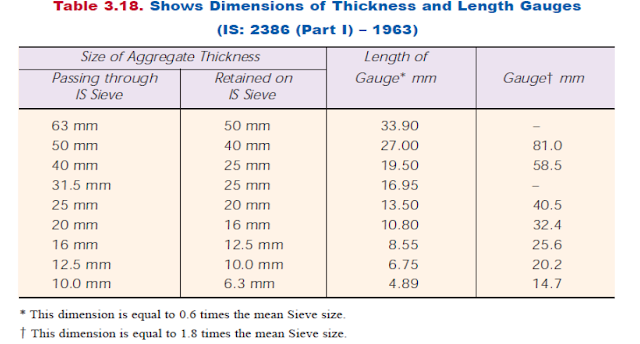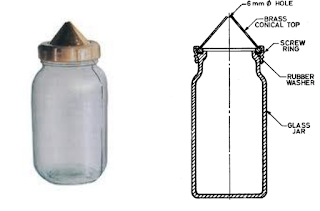Objective : This method of test methods of determining the abrasion value of coarse aggregate, by the use of Los Angeles machine.
Reference : IS : 2386 ( Part IV) – 1963, IS: 383-1970
Theory : Abrasive Charge-The abrasive charge shall consist of cast iron spheres or steel spheres approximately 48 mm in. diameter and each weight between 390 and 445 g.
The test sample consist of clean aggregate which has been dried in an oven at 105°C to 110°C and it should conform to one of the gradings shown in Table 3.22.
Apparatus :
Los Angeles machine - The Los Angeles abrasion testing machine shall consist of a hollow steel cylinder, closed at both ends, having an inside diameter of 700 mm and an inside length of 500 mm. The cylinder shall be mounted on stub shafts attached to the ends of the cylinders but not entering it, and shall be mounted in such, a manner that it may be rotated about its axis in a horizontal position. An opening in the cylinder shall be provided for the introduction of the test sample. A removable steel shelf, projecting radially 88 mm into the cylinder and extending its full length, shall be mounted along one element of the interior surface of the cylinder. The shelf shall be of such thickness and so mounted, by bolts or other approved means, as to be firm and rigid. The 1.70 mm IS Sieve.
Figure :
Procedure :
1. The test sample shall consist of clean aggregate which has been dried in an oven at 105 to 110°C to substantially constant weight and shall conform to one of the gradings shown in Table 3.22. The grading or gradings used shall be those most nearly representing the aggregate furnished for the work.
2. The test sample and the abrasive charge shall be placed in the Los Angeles abrasion testing machine and the machine rotated at a speed of 20 to 33 rev/min. For gradings A, B, C and D, the machine shall be rotated for 500 revolutions; for gradings E, F and G, it shall be rotated for 1 000 revolutions.
3. The machine shall be so driven and so counter-balanced as to maintain a substantially uniform peripheral speed. If an angle is used as the shelf, the machine shall be rotated in such a direction that the charge is caught on the outside surface of the angle.
4. At the completion of the test, the material shall be discharged from the machine and a preliminary separation of the sample made on a sieve coarser than the l.70 mm IS Sieve.
5. The material coarser than the 1.70 mm IS Sieve shall be washed dried in an oven at 105 to 110°C to a substantially constant weight, and accurately weighed to the nearest gram.
Calculation :
The difference between the original weight and the final weight of the test sample is expressed as a percentage of the original weight of the test sample. This value is reported as the percentage of wear.
Aggregate Abrassion Value=B/A*100
B weight in g of fraction passing through 1.70 mm IS Sievs
A weight in g of saturated surface - dry sample,
Conclusion / Result :
The aggregate Abrasion Value of given sample of coarse aggregate is ……….. %
The percentage of wear should not be more than 16 per cent for concrete aggregates.
Reference : IS : 2386 ( Part IV) – 1963, IS: 383-1970
Theory : Abrasive Charge-The abrasive charge shall consist of cast iron spheres or steel spheres approximately 48 mm in. diameter and each weight between 390 and 445 g.
The test sample consist of clean aggregate which has been dried in an oven at 105°C to 110°C and it should conform to one of the gradings shown in Table 3.22.
Apparatus :
Los Angeles machine - The Los Angeles abrasion testing machine shall consist of a hollow steel cylinder, closed at both ends, having an inside diameter of 700 mm and an inside length of 500 mm. The cylinder shall be mounted on stub shafts attached to the ends of the cylinders but not entering it, and shall be mounted in such, a manner that it may be rotated about its axis in a horizontal position. An opening in the cylinder shall be provided for the introduction of the test sample. A removable steel shelf, projecting radially 88 mm into the cylinder and extending its full length, shall be mounted along one element of the interior surface of the cylinder. The shelf shall be of such thickness and so mounted, by bolts or other approved means, as to be firm and rigid. The 1.70 mm IS Sieve.
Figure :
Procedure :
1. The test sample shall consist of clean aggregate which has been dried in an oven at 105 to 110°C to substantially constant weight and shall conform to one of the gradings shown in Table 3.22. The grading or gradings used shall be those most nearly representing the aggregate furnished for the work.
2. The test sample and the abrasive charge shall be placed in the Los Angeles abrasion testing machine and the machine rotated at a speed of 20 to 33 rev/min. For gradings A, B, C and D, the machine shall be rotated for 500 revolutions; for gradings E, F and G, it shall be rotated for 1 000 revolutions.
3. The machine shall be so driven and so counter-balanced as to maintain a substantially uniform peripheral speed. If an angle is used as the shelf, the machine shall be rotated in such a direction that the charge is caught on the outside surface of the angle.
4. At the completion of the test, the material shall be discharged from the machine and a preliminary separation of the sample made on a sieve coarser than the l.70 mm IS Sieve.
5. The material coarser than the 1.70 mm IS Sieve shall be washed dried in an oven at 105 to 110°C to a substantially constant weight, and accurately weighed to the nearest gram.
Calculation :
The difference between the original weight and the final weight of the test sample is expressed as a percentage of the original weight of the test sample. This value is reported as the percentage of wear.
Aggregate Abrassion Value=B/A*100
B weight in g of fraction passing through 1.70 mm IS Sievs
A weight in g of saturated surface - dry sample,
Conclusion / Result :
The aggregate Abrasion Value of given sample of coarse aggregate is ……….. %
The percentage of wear should not be more than 16 per cent for concrete aggregates.
























